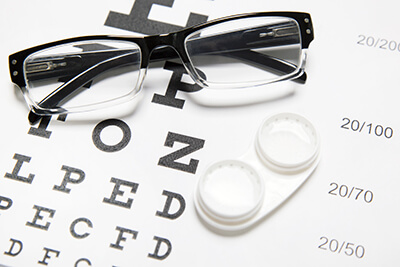Optical Prescriptions
Many patients want to understand what the numbers signify on a prescription for glasses or contact lenses. Unlike an eye test, an optical prescription is not a direct measurement of the ability to see. It does not compare eyesight with that of someone who has perfect vision, the way an eye chart does. Instead, the prescription is a specification of the power required to correct vision to normal.
Refractive errors occur when light rays entering the eye cannot focus precisely on the middle of the retina. When this happens the retina is incapable of relaying a clear message to the brain and you can’t see clearly. Corrective lenses bend the light rays to focus more directly onto the retina. The amount of correction necessary is written as a prescription.
Refractive errors occur when light rays entering the eye cannot focus precisely on the middle of the retina. When this happens the retina is incapable of relaying a clear message to the brain and you can’t see clearly. Corrective lenses bend the light rays to focus more directly onto the retina. The amount of correction necessary is written as a prescription.

ALL OPTICAL PRESCRIPTIONS INCLUDE:
- The powers for lenses of each eye, right and left (OD and OS)
- Possibly additional power(s) for reading or mid-range and reading (bifocals or trifocals)
- How far apart the optical center of the lenses should be (PD) – the distance between the centers of each pupil
- Any special requirements for the lenses (type of lens, tinting, coatings, etc.), if required
THE TERMINOLOGY:
- D – is an abbreviation for diopters, a mathematical metric notation relating to the focal point of light passing through a lens (100 divided by the focal point in centimeters)
- OD – refers to the right eye and comes from the Latin Oculus dextrum
- OS – refers to the left eye and comes from the Latin Oculus sinistrum
- Add – Additional power for multi focal lenses, such as bifocals or progressives for reading
- PD – Interpupillary distance (from the center of one pupil to the center of the other pupil) measured in millimeters
A PRESCRIPTION IS ALWAYS WRITTEN IN A PARTICULAR ORDER:
The first number indicates myopia or hyperopia:
- The number indicates the degree of refractive error
- A minus sign (-) indicates myopia (nearsightedness)
- A plus sign (+) indicates hyperopia (farsightedness)
Mild to moderate myopia = in the range of -1 to -6 diopters.
Mild to moderate hyperopia = within the range of +0.75 to +4.00 diopters.
A second number indicates both the presence of astigmatism and the degree of it. Astigmatism may have either a minus sign or a plus sign. Most everyone has some degree of astigmatism.
A third number, called axis, indicates the direction of astigmatism
An example might look like:
- OD: +1.50 +1.00 x 035
OS: +1.75 +1.25 x 135
Add: +1.50
PD: 62
It would mean:
- OD: the right eye
+1.50: spherical power (positive) indicates hyperopia
+1.00 x 035: cylindrical lens of positive power with axis at 35 degrees, for correction of astigmatism - OS: the left eye
+1.75: spherical power (positive) indicates hyperopia
+1.25 x 135: cylindrical lens of positive power with axis at 135 degrees, for correction of astigmatism - Add: +1.50 means this prescription includes a bifocal application for reading
- PD: the distance from the center each pupil to pupil is 62 millimeters